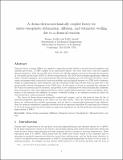| dc.contributor.author | Loeffel, Kaspar Andreas | |
| dc.contributor.author | Anand, Lallit | |
| dc.date.accessioned | 2017-03-27T19:18:17Z | |
| dc.date.available | 2017-03-27T19:18:17Z | |
| dc.date.issued | 2011-09 | |
| dc.date.submitted | 2011-03 | |
| dc.identifier.issn | 07496419 | |
| dc.identifier.uri | http://hdl.handle.net/1721.1/107735 | |
| dc.description.abstract | Thermal barrier coatings (TBCs) are applied to superalloy turbine blades to provide thermal insulation and oxidation protection. A TBC consists of an oxide/metal bilayer: the outer oxide layer (top-coat) imparts thermal insulation, while the metallic layer (bond-coat) affords oxidation protection through the formation of a thermally-grown-oxide (TGO) at elevated temperatures. The TGO layer possesses significantly different elastic, thermal expansion, and creep properties than the surrounding top-coat and bond-coat layers. An intrinsic mechanism which controls the long-term stability and mechanical integrity of a TBC is the volumetric change accompanying the oxide formation, and the attendant locally large stresses that can arise due to the geometrically uneven development of the TGO layer. In this paper we focus on modeling the response of the bond-coat material and its oxidation, and present a new continuum-level thermodynamically-consistent, large-deformation, fully three-dimensional theory which couples high-temperature elastic–viscoplastic deformation of the material with diffusion of oxygen, eventually leading to an oxidation reaction in which the reaction-product causes permanent swelling.
The theory is chemo-thermo-mechanically coupled and complex, and at this point in time the list of material parameters appearing in the theory are not fully known. Once the material parameters in our theory are calibrated from suitable experiments, and the theory is numerically-implemented and validated, then the numerical simulation capability should provide an important ingredient for analyzing the evolution of the local stress and strain states which are important ingredients for the life-prediction and performance-improvement of TBCs. | en_US |
| dc.description.sponsorship | Center for Clean Water and Clean Energy at MIT and KFUPM | en_US |
| dc.description.sponsorship | King Fahd University of Petroleum and Minerals (KFUPM) | en_US |
| dc.language.iso | en_US | |
| dc.publisher | Elsevier B.V. | en_US |
| dc.relation.isversionof | http://dx.doi.org/10.1016/j.ijplas.2011.04.001 | en_US |
| dc.rights | Creative Commons Attribution-NonCommercial-NoDerivs License | en_US |
| dc.rights.uri | http://creativecommons.org/licenses/by-nc-nd/4.0/ | en_US |
| dc.source | Prof. Anand | en_US |
| dc.title | A chemo-thermo-mechanically coupled theory for elastic–viscoplastic deformation, diffusion, and volumetric swelling due to a chemical reaction | en_US |
| dc.type | Article | en_US |
| dc.identifier.citation | Loeffel, Kaspar, and Lallit Anand. “A Chemo-Thermo-Mechanically Coupled Theory for Elastic–viscoplastic Deformation, Diffusion, and Volumetric Swelling Due to a Chemical Reaction.” International Journal of Plasticity 27, no. 9 (September 2011): 1409-1431. | en_US |
| dc.contributor.department | Massachusetts Institute of Technology. Department of Mechanical Engineering | en_US |
| dc.contributor.approver | Anand, Lallit | en_US |
| dc.contributor.mitauthor | Loeffel, Kaspar Andreas | |
| dc.contributor.mitauthor | Anand, Lallit | |
| dc.relation.journal | International Journal of Plasticity | en_US |
| dc.eprint.version | Author's final manuscript | en_US |
| dc.type.uri | http://purl.org/eprint/type/JournalArticle | en_US |
| eprint.status | http://purl.org/eprint/status/PeerReviewed | en_US |
| dspace.orderedauthors | Loeffel, Kaspar; Anand, Lallit | en_US |
| dspace.embargo.terms | N | en_US |
| dc.identifier.orcid | https://orcid.org/0000-0002-4581-7888 | |
| mit.license | PUBLISHER_CC | en_US |
